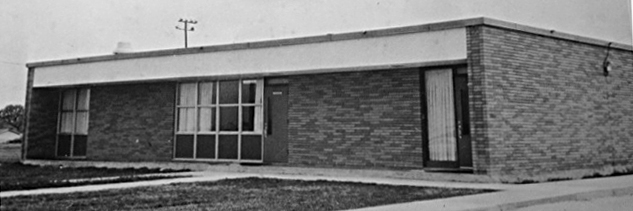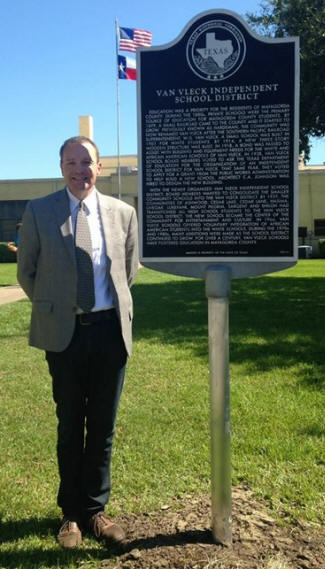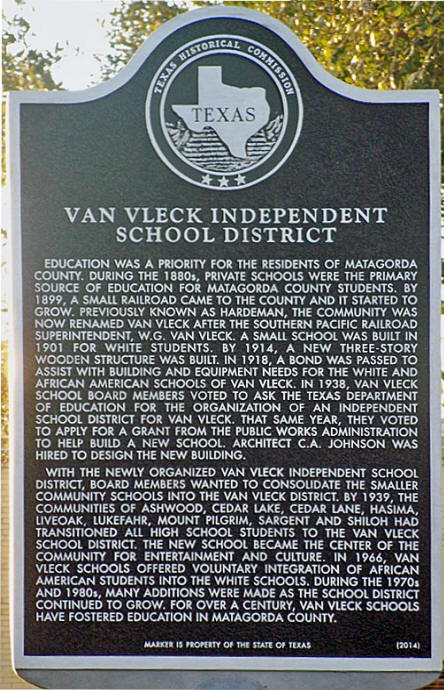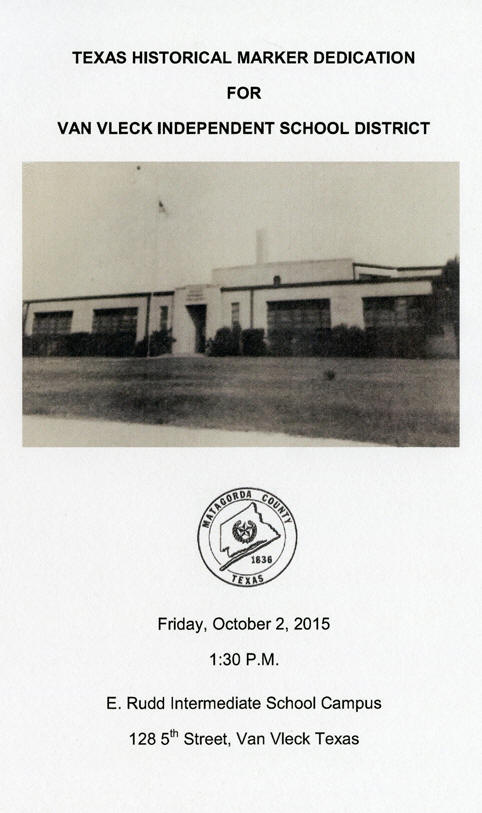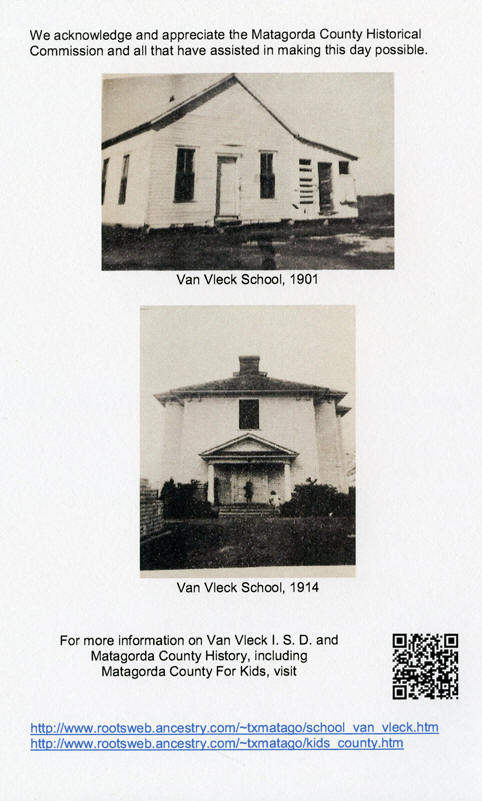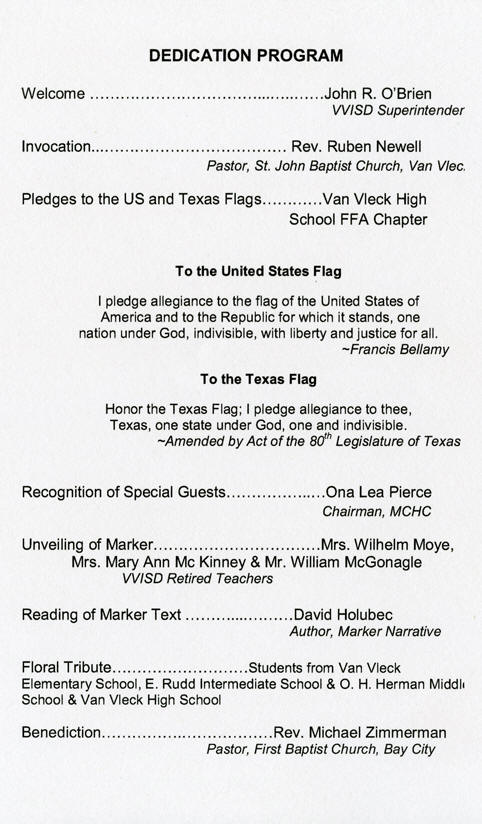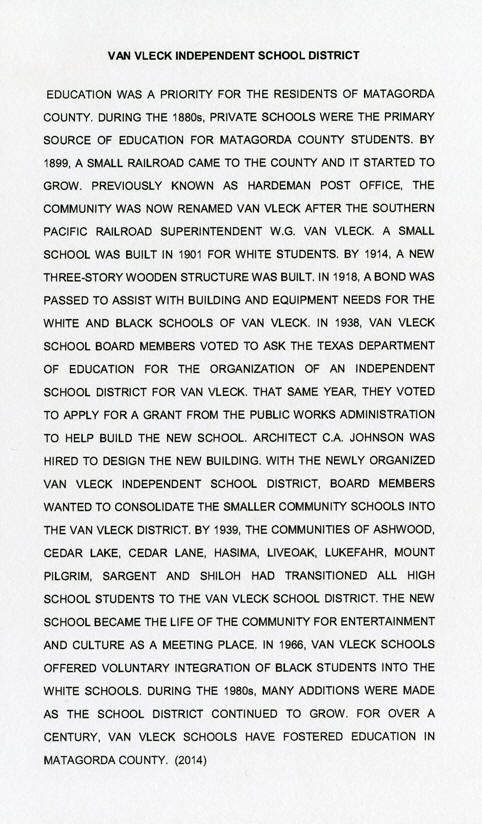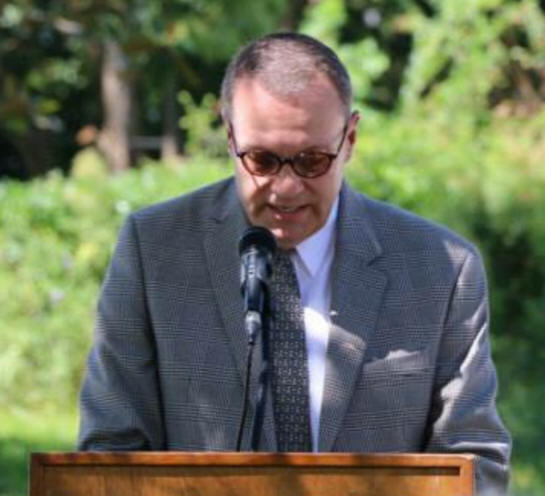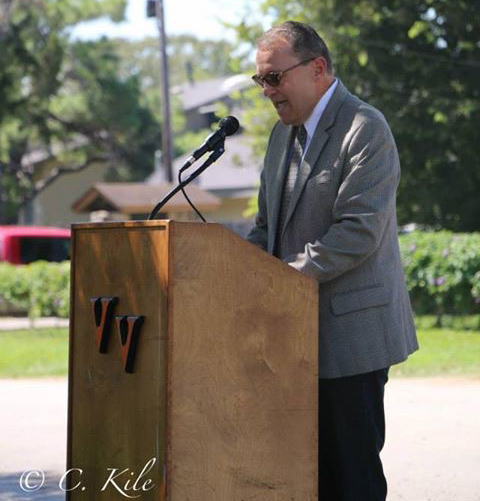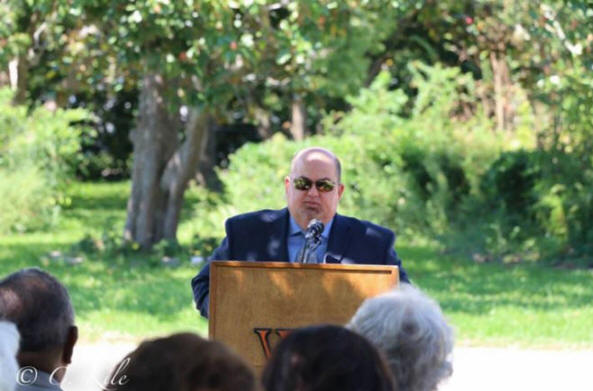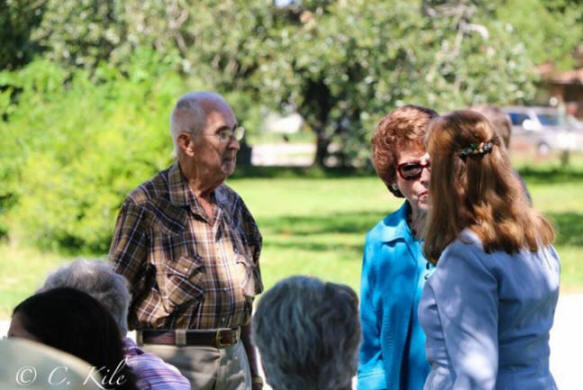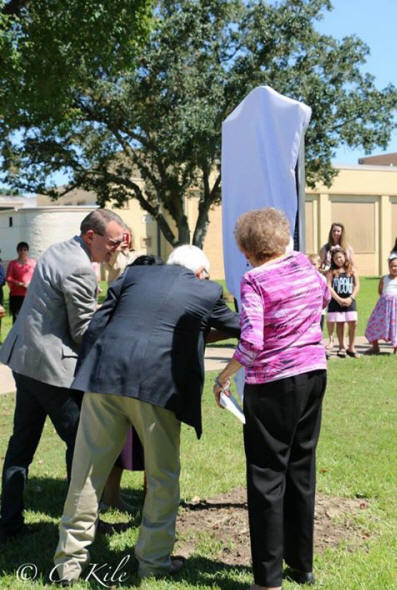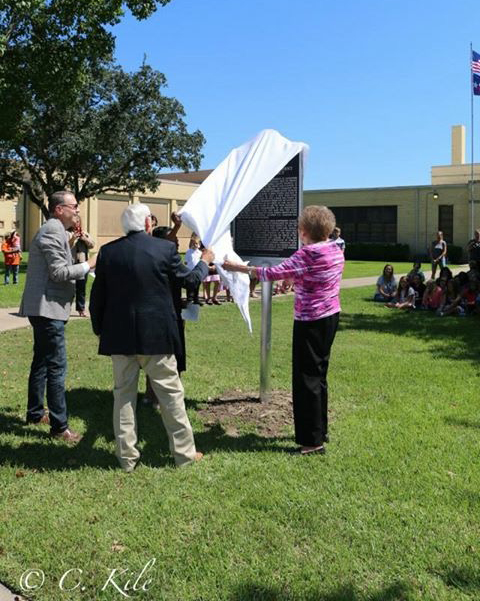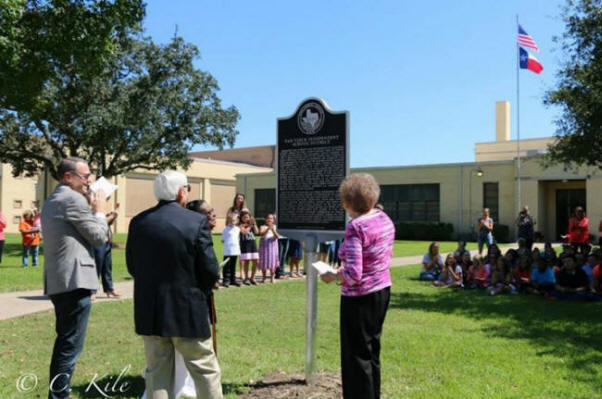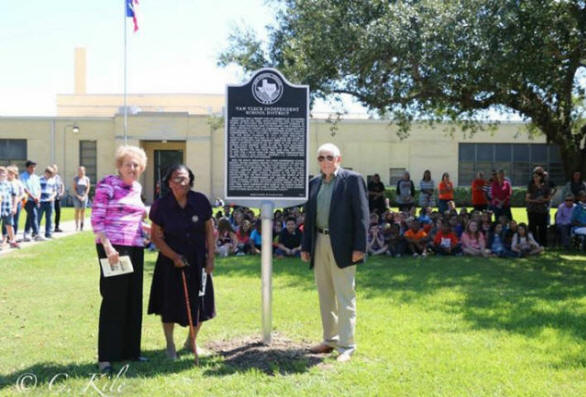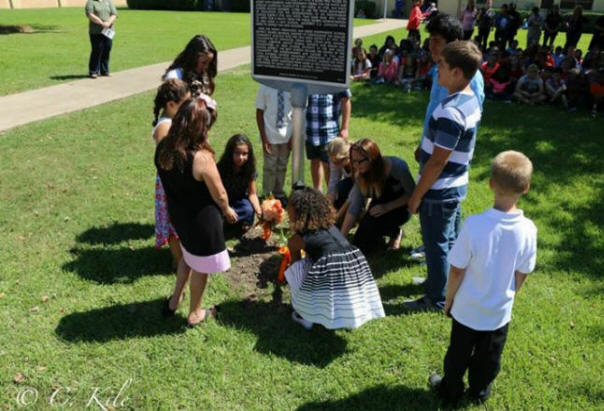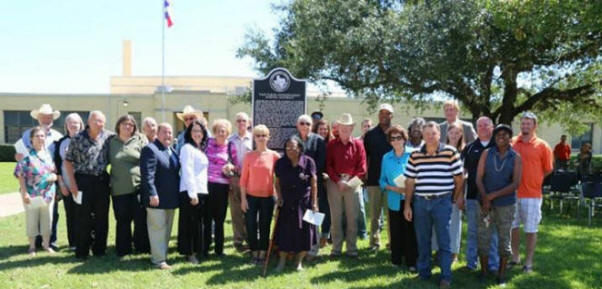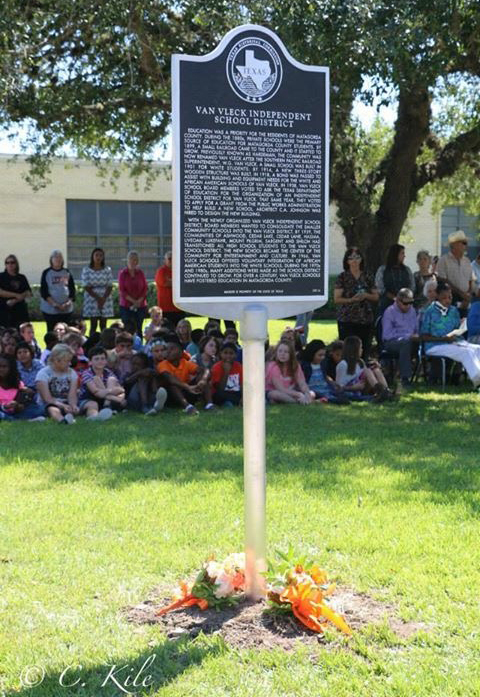|
Van Vleck Independent School District By David Holubec |
|
Bailey Hardeman (1795 1836), signer of the Texas Declaration of Independence, migrated to Texas from Tennessee in 1835. He settled on the banks of Caney Creek. Other Hardeman family members followed and a thriving community called Hardeman Post Office (1860 1901) was born.
Education was a priority to the earliest residents of Matagorda County. School was held early in the settlement of most of the communities--usually under less than acceptable circumstances and with few materials. During the 1800s, private schools were the primary avenues for educating Matagorda County students. Many plantation owners employed private tutors for their children.
Prior to the Civil War, educating black students was against the law, but post-war, schools for black children formed in most communities. Public education for all students became more organized in the late 1800s.
The September 17, 1897 issue, of the Bay City Breeze stated, Our school (Hardeman Post Office) started last Monday with Miss Tenie Hardeman as teacher. We only have enough for three months.
Reverend Sloan and Reverend Green, in nearby Bay City, privately taught some students in the area. William Phillip Johnson (1897 - 1975) of the Hardeman Post Office area was one of the students taught by the two men.
George James Rainey (1884 - 1973) remembers being taught in his home by Mrs. Tenie (Hardeman) Gibson and Annie Huck (b.1883). He later attended the new Van Vleck School built around 1901.
By late 1899, a small railroad had made its way into Matagorda County and pushed its way through the old Hardeman Post Office area now known as Van Vleck. The area continued to grow and gained its name from one of its prominent residents, Southern Pacific Railroad Superintendent, W. G. Van Vleck (1857 1914). Mr. Van Vleck came to the area from Wharton, Texas and lived in Annie Mae Johnsons (1904 1943) rooming house.
This small structure would be the beginning of organized educational endeavors by the citizens of Van Vleck that would continue to grow and improve into the Twenty-First Century.
Due to an increase in the school age population in 1909, and an increase in school tax revenue, Matagorda County was able to hire a county school superintendent. County Judge Thomas H. Lewis was the first in that office, from 1909 - 1914; W. C. Gray, 1914 - 1916; W. F. Pack, 1916 - 1921; Mabel Kennedy, 1921 -1923; W. T. Pollard, 1923 - 1924; Mrs. W. T. Pollard, 1924 - 1934; Tom Hale 1934 - 1965; and E. E. Rudd, 1965 - 1975.
The 1901, white clapboard building served the needs of the white students in Van Vleck until it was announced in April, 1911 that bonds would be voted upon at Van Vleck for the erection of a new school building. T. M. Gregory was appointed presiding judge. By 1914, a three-story wooden structure was built to house the white school children of Van Vleck. In 1918, another bond was passed to assist the Van Vleck Schools with building and equipment needs for the white and black schools.
On February 25, 1938, Van Vleck School Board members voted to send a letter to Mr. T. P. Walker (b.1882) at the Texas Department of Education in Austin, Texas, requesting the organization of an independent school district for Van Vleck. Board members were, Penola Jones Johnson (1902 1999), Irma Bickham Rugeley (1891 1967), Thomas Lee Rugeley (1875 1957), Ora Lee Shiver Bickham (1907 2003), W. T. Orrell (1905-1974), Vincent L. Holub (1886 - 1956) and Joseph Samuel Richardson (1898 1989).
The Van Vleck School board members voted on March 3, 1938 to purchase Block 53 of Van Vleck Original Townsite, owned by Mrs. G. B. Johnson, and Block 47, Lots 1-6 of Van Vleck Original Townsite, owned by Ethel Shockley (1884 1972) of Knott, Texas. On March 14, 1938, the school board announced the results of the latest bond election. Seventy-seven votes were received to issue the $35,000 bonds and twenty votes against. The bonds were to be paid out in thirty-five years and were to be used for the purpose of purchasing property, equipment and to erect a new school building.
On April 28, 1938, the school board voted to request from the Matagorda County School superintendent, a two-year high school classification for the Van Vleck School. Mr. Elijah E. Rudd (1902 1985) was hired by the board as the first superintendent of schools for Van Vleck on May 7, 1938. Mr. Rudd was issued a two-year contract which provided a salary of $150 per month.
May 28, 1938, the board voted to make an application with the Public Works Administration (PWA) for a grant to help build the new school. Board members received a telegraph from Washington, D.C. on September 16, 1938 stating that Van Vleck Independent School District had been awarded the Public Works Administration grant in the amount of $28,830. Architect C. A. Johnson was hired to design the new school and Ratcliffe & Flemming of Livingston, Texas, were awarded the contract to build the building at a cost of $59,068.
Many smaller communities surrounding Van Vleck had small schools for white and black students. With the newly organized Van Vleck Independent School District and the new building project underway, school board members sought the consolidation of those smaller community schools into the Van Vleck district. By the end of 1939, the school officials for the communities of Ashwood, Cedar Lake, Cedar Lane, Hasima, Liveoak, Lukefahr, Mount Pilgrim, Sargent, and Shiloh, had transitioned all high school students to the Van Vleck School District. The completion of this consolidation for all students in these small communities, would not take place until July 30, 1948 for white students and June 3, 1953 for the remaining black students.
The newly constructed school building was designated for emergency first-aid use during World War II, on January 8, 1942. The structure became a meeting place, not only for school related functions, but also community events. The school became the life of the community in the way of entertainment and culture. During Hurricane Carla, on September 11, 1961, the school building was used as a shelter for many rural families as they weathered the category five storms. Van Vleck High School was designated a full four-year high school in 1941- 42.
On April 16, 1947, board members voted to purchase adjoining property from Mrs. Gillie Johnson (1881-1955), not to exceed $1,200. On May 22, 1947 the motion was approved to hold a bond election for $125,000 to be used for building additions to both white and black schools. Architect, C. A. Johnson was hired to design the additions and R. P. Farnsworth was hired as the general contractor. An addition to the black school (present middle school), new auditorium, classrooms and a gymnasium were the scope of the project at a cost of $484,889. Carl H. Stautz (1909 1977), architect and Baugh and Scott, general contractors. Completion was in 1949. The new auditorium was used for graduation ceremonies, school plays and special events. Concerts, traveling western shows and theater movies were held in the auditorium for the benefit of the community.
Van Vleck Independent School District continued to grow. On April 21, 1949, the school census showed 317 white students and 373 black students, for a total student population of 690 students.
Two additional lots adjoining the school were purchased from Gayle Watkins (1916 1961) on June 27, 1951. After superintendent, Elijah Rudds contract expired; the board hired John D. Wallace (1890 1956) as superintendent of schools for Van Vleck on May 9, 1952. On April 7, 1953, Hal Robbins (1909 1974) was hired as principal of Herman High School (black school), and Joel Williams (1889 1995) was hired as an assistant principal, teacher and bus driver.
A new band hall was approved on June 15, 1953 at a cost of $11,965. On November 4, 1957, the board voted to hold a bond election in the amount of $350,000 for repairs, purchases and for the construction of a new school (present high school) and stadium. Architect, Matt E. Howard (1928 1982) and Associates were hired to design the new structures and Walter Droemer (1914 1984) as contractor. W. R. Dendy (1906 1981) was the superintendent of schools during this time. The construction was completed in 1958.
In 1966, Van Vleck schools offered voluntary integration of black students into the white schools. A young black girl, Thelma Smith Mack (1948 - ), was the only black female graduating in the Van Vleck High School class of 1966. She wrote a book about her experience entitled, Wisdom Born of Pain. In 1968, all Van Vleck Schools were integrated successfully.
September 10, 1970 a four-foot cyclone fence was placed around the football field and stadium. Roy Stockstill (1918 1980) was hired on March 29, 1971 as the superintendent of schools. Kindergarten was opened to all students on August 29, 1972. With more kindergarten students and the steady growth of the general student population, the board members voted on November 1, 1972 to hold a bond election for the sale of $2,250,000 in bonds for the construction of a new elementary school and a modern vocational agriculture science building. Engberg, Simmons, Cavitt, McKnight and Weymouth architects designed the buildings and the general contractor was Drymalla Construction Company. Both buildings were completed in 1974. On March 13, 1975, the board approved the construction of high school tennis courts.
As the school district continued to grow, many additions were made during the 1980s. In 1981 a new band hall was built at the high school. In 1985, a new high school cafeteria was constructed and an addition was made to the administration building. The new Van Vleck Junior High School band hall was completed in the fall of 1995. Additions and renovations to the auditorium and high school gym updated the two buildings to better serve the drama and athletic departments.
On February 12, 1996, the names of Van Vleck Junior High and Van Vleck Intermediate Schools were officially changed to honor two education pioneers in Van Vleck school history. Van Vleck Junior High was renamed O. H. Herman Middle School after long-time, African American school board member and civic leader Octave H. Herman (1862-1958). Van Vleck Intermediate School was renamed E. Rudd Intermediate School after the first Van Vleck superintendent, Elijah E. Rudd. Carrie Yeager Rudd (1910 - 2010), wife of former superintendent, Elijah E. Rudd, bequeathed $100,000 to the school that was named after her husband upon her death in 2010.
Van Vleck Independent School District has had many notable graduates that excelled in their specific careers. The graduates include doctors, college professors and many public school educators.
Notable Van Vleck graduate, Charles Austin (1967 - ), graduated from Van Vleck High School in 1986. Austin was an exceptional athlete and went on to win a gold medal in the mens high jump at the 1996 Summer Olympics in Atlanta. He was inducted into the United States Track and Field Hall of Fame in 2012.
Numerous NFL players got their start on the football field in Van Vleck. Graduate, Eric Wayne Martin (1961 - ), played college ball for Louisiana State University. He then played professionally for the New Orleans Saints and the Kansas City Chiefs from 1985 1994. Robert James Blackmon (1967 - ), played college ball for Baylor University. He then played professionally for the Seattle Seahawks and the Indiana Colts from 1990 1998. Others include, Michael Douglas Hawkins (1955 - ) with the New England Patriots and the Los Angeles Raiders from 1978 1982, and his brother, Anthony James Hawkins (1958 - ), played for the Tampa Bay Buccaneers, Houston Gamblers, San Diego Chargers and the Kansas City Chiefs from 1980 1988.
The current (2013) Van Vleck Independent School District superintendent, John Robert OBrien (1964 - ), is a graduate of the Van Vleck High School Class of 1983, Texas A&M University in 1988, and the University of Houston in 2000. OBrien became superintendent in July 2011. He has successfully led the school district during a time of shrinking state funding and growth in the community and the student population.
Van Vleck
Independent School District continues to educate students in an area
which covers 338 square miles of the northeastern portion of
Matagorda County. The schools in Van Vleck continue to have
excellent ratings by the Texas Education Agency and maintain high
standards for its teachers and students. The school district
continues to modernize its facilities and academic programs. On-line
classes and innovative teaching programs continue the successful
tradition of education in Van Vleck, Texas. We owe much to our
founding board members, teachers, principals, administrators and
parents.
|
|
|
Copyright 2015 -
Present by VVISD |
|
| Created Oct. 5, 2015 |
Updated Oct. 5, 2015 |
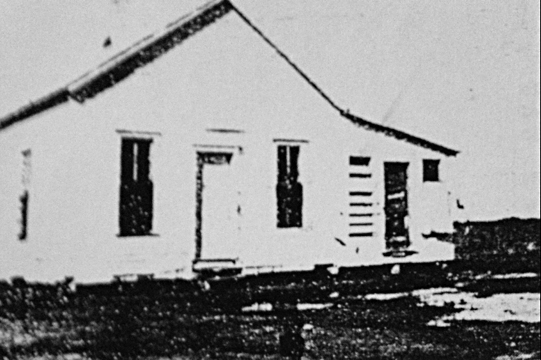 With the coming
of the railroad, came more students in need of educating in the Van
Vleck area. A small school was built in 1901 for the white students.
The building was a one room structure that was used to house the
students for a school term of around three-months, thus becoming the
first structure built specifically to house a school in Van Vleck,
Texas.
With the coming
of the railroad, came more students in need of educating in the Van
Vleck area. A small school was built in 1901 for the white students.
The building was a one room structure that was used to house the
students for a school term of around three-months, thus becoming the
first structure built specifically to house a school in Van Vleck,
Texas. 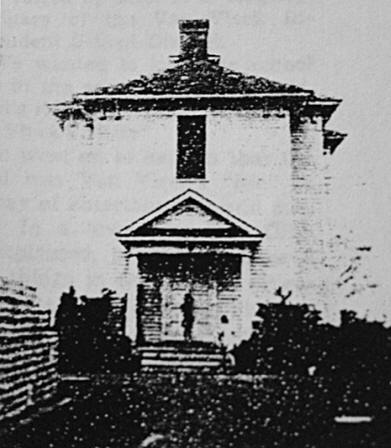 From 1914 to
1938 the white students of Van Vleck were served by the three-story,
wooden structure that sat outside Van Vleck and was overseen by the
Matagorda County Superintendent of Schools. The black students were
housed in a different school building. Both schools taught grades
one through nine. In 1934, Miss Wilmoth McMahon (1910 - 1989) was a
teacher at the white school along with principal, Daisy Bell Newton
(1904 1999). Elena Smith taught at the black school. In 1935,
Lillian Herman (1885 1969) was the principal of the Van Vleck
School and taught grades six and seven with Mildred Herman teaching
primary, Etta Mae Baker (1896 1967) teaching grades two and three
and Margaret Gibson (1911 2007) teaching grades four and five. The
Van Vleck black school was served by principal, Rosa Lee Allen (1914
1955) and assistant, Daisy Lee Revis (1916 - 2010).
From 1914 to
1938 the white students of Van Vleck were served by the three-story,
wooden structure that sat outside Van Vleck and was overseen by the
Matagorda County Superintendent of Schools. The black students were
housed in a different school building. Both schools taught grades
one through nine. In 1934, Miss Wilmoth McMahon (1910 - 1989) was a
teacher at the white school along with principal, Daisy Bell Newton
(1904 1999). Elena Smith taught at the black school. In 1935,
Lillian Herman (1885 1969) was the principal of the Van Vleck
School and taught grades six and seven with Mildred Herman teaching
primary, Etta Mae Baker (1896 1967) teaching grades two and three
and Margaret Gibson (1911 2007) teaching grades four and five. The
Van Vleck black school was served by principal, Rosa Lee Allen (1914
1955) and assistant, Daisy Lee Revis (1916 - 2010).